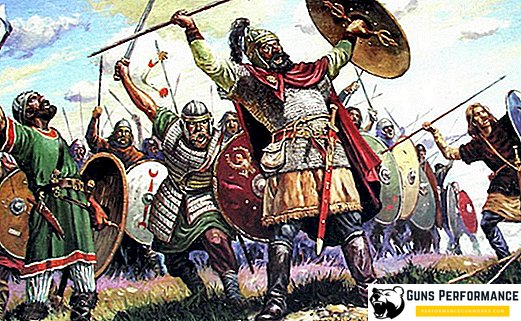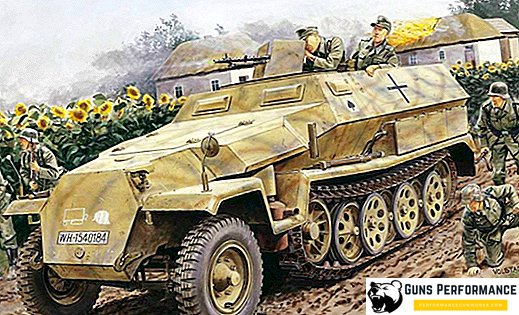
The concept of "barbarians" appeared in ancient Greece. That was the name of any foreigners who arrived in Greece from another country. Subsequently, the Greek tradition settled down in ancient Rome. Roman citizens were considered barbarians by any people who did not belong to Roman culture.
Who are the barbarians, where did this name come from?
At present it is difficult to say where the name "barbarians" came from. There is only one assumption, which may partially explain its origin. The ancient Greeks knew the tribe of Varii, which are found in the written sources of those years. It is not known for sure whether Warius were Germans, Celts or any other people, but they lived not far from the island of Rügen.
It is possible that the Vaari were a super ethnos, which was later divided into several large tribes. At least the historians and chroniclers of ancient Rome knew the following barbarian peoples:
- Scythians;
- The Germans;
- Alans;
- Ready;
- Sarmats;
- Gauls and many more barbarian tribes.
Most of the barbarian tribes were distinguished by their militancy and constantly raided the border areas of the Roman Empire.
But the ancient Greeks divided the barbarians only into two tribes:
- Hyperborean;
- Scythians.
If the Hyperboreans understood all the foreigners from the northern lands, then the Scythians were understood as the tribes of the northern Black Sea coast.
The descendants of Hercules - the Scythians

The ancient Scythians, considered the ancestors of Russian barbarians, were known to the ancient Greeks as harsh and cruel warriors. They periodically attacked the lands of the Greeks and their allies, but since their tribes were scattered, they did not cause significant damage. However, the Scythians were often hired as mercenaries and guards.
Even in those times, some Scythian tribes were influenced by Hellenic culture and began to lead a sedentary life. They were engaged in trade and crafts, and their religion almost did not differ from the Greek. Currently preserved samples of Scythian culture, made of gold and precious stones. They are made by masters of their craft who are not inferior to the best Greek masters of the time.
According to Herodotus, the main gods of cultural Scythians were:
- Hercules;
- Ares;
- Hestia;
- Zeus and other Greek gods.
The fact that the gods of war stand at the head of the Scythian pantheon clearly testifies to the militancy of this nation.
Alans - the legendary descendants of Trojans

The barbaric tribes of the Alans, which are mentioned in the annals as aces, Roksalans or Yazigi, were nomads moving along the steppes of the Volga and Dnieper regions. It is very likely that it was the Alans who were the most legendary Asami Trojans. Not all Alans were nomads. Some of them were sedentary, and lived in clay semi-earths.
The ancient geographer Strabo, referring to the Alans, calls them the last known Scythians, and tells about the battle of the Roksalans with the Persian king Mithridates. In that battle, the Alanian tribes were able to gather an army of 50,000 soldiers to help the Scythian king Palak. Despite their courage, the barbaric armadas could not resist the civilized army of the Persians and were defeated.
The next mention of Asses-Alans appeared around the 2nd century BC. Then these barbaric tribes suddenly appeared in the territories of the modern Crimea, where they began to fight with the Bosporian Scythian state.
Goths and famous conquests of Germanarich

Soon, in search of more fertile lands on the Black Sea territory, violent Gothic tribes came. Having come along with their leader Berebysta, the Goths immediately ruined the following countries:
- Illyria;
- Thrace;
- Many Celtic tribes.
Having come to Dacia, the Goths mixed with the local barbarians of the Dakas, as they were related tribes. Strabo argued that they also got along well with the ancient Germans, constantly entering into military alliances against Rome. However, for ancient Rome, the raids of the barbarians at that time were not terrible. As a rule, the border areas of the empire suffered, which were settled by the conquered peoples. For the barbarians, a march on Rome was a real adventure, which could bring both tremendous wealth and fame, and lead to the death of half the troops.
The most famous Gothic commander became Germanarich. His military campaign took place in the second half of the 4th century AD. The conquests of the Gothic leader took place as follows:
- At first, the herrules were conquered;
- Then the army of Germanarich defeated the kingdom of Bosporus;
- Next were crushed antes, claves and part of the Veneti.
After that, having gathered the conquered tribes under their banners, the famous commander made a grand military campaign, which began from the Baltic Sea, and ended in the east of Byzantium.
Like most barbarian commanders, the leader is ready to die a violent death. Hermanarich was stabbed to death by the sword of one of his wives, whom he ordered to tear the horses apart.
The barbaric tribe of the Veneti
The life of the barbarians of the Veneti tribe proceeded in the northern territories, not far from the Baltic Sea. Some scientists consider this tribe descendants of the Wans, who were mentioned in the ancient Greek "Younger Edda". The origin of the Veneti is still unclear. There are several points of view on this matter:
- It is possible that venety are related to vandals;
- According to one version, the Venets are the ancestors of the Western Slavs;
- Some give a description of the Venetian warriors, claiming that they are similar to the Russians.
Most scientists agree that the Wends and the Vandals are representatives of the same super ethnic group.
Vandals - Destroyers of Rome

About a tribe of vandals in the modern world almost everyone knows. The word "vandal" has long become a household word. Vandals are called rude and uncultured people. In the 15th century, the outstanding enlightener Mavro Orbini proved that this tribe is related to the Slavs. Orbini used the works of Roman and Greek authors as sources of information.
This theory is partly confirmed by Polish legends, which indicate that their people came from Prince Vandal. Even in the Russian chronicles there is a legend about the king of Novgorod Vandal, who was the ancestor of all Slavs.
How the barbarians conquered the Roman Empire
Although Rome managed to conquer and subjugate vast territories, the eastern lands still lived their original life. Of course, there could be no question of any barbarian Empire, but the tribes often entered into alliances and together organized campaigns in the territory of the Roman Empire. Although the border of the Roman Empire was protected, the cohorts of legionnaires could not be in several places at the same time. This was the main component of the military strategy of the barbarians. Suddenly, hitting the border areas, the barbarians burned and plundered everything in their path.
The year 370 was of great importance for the future of the whole Roman Empire. This year the Hunnic warriors attacked the Alans, who were fighting against the Goths. Because of this, the Alans and the Goths united, and tried to repel the Hun hordes. The battle ended in defeat, and the remnants of the Goths and Alans invaded the Balkan lands. There, they defeated most of the local tribes, after which they entered into a series of military alliances with the Vandals, the Burgundians, and the Swabs against Rome.
Already in 406, the united barbarian army invaded the territory of Italy, where it managed to plunder and destroy not only villas and settlements, but also many large cities, among which were Florence. The most important among the commanders of the barbarian army was Radigast. Judging by the name, this leader came from a noble family. If you believe the legends, the leader of the army of barbarians vowed to destroy Rome to the ground.
Most likely, the huge army of Radigast, which had gathered under its banner, would have destroyed the eternal city, but it was almost death just below the city itself. For the inhabitants of the Roman Empire, the name Radigast personified horror. Everywhere, where the army passed, huge human sacrifices were made. Barbarians did not even spare the children.
The bloody march of barbarians in Europe

Since the Roman army in Italy could not detain the barbarians, their hordes headed to the West. In 409, the united army, consisting of Alans, Svevs and Vandals, entered the territory of Spain. Commanded by a barbarian horde, King Gunterich. With the help of the local commander Gerontus, who, taking advantage of the situation, decided to rebel against Rome, the barbarians defeated the Spanish legions, establishing their authority over the Iberian Peninsula. The conquered territory was divided as follows:
- Alans received the territory on which modern Portugal and part of central Spain are located;
- Vandals got the territory of modern Andalusia;
- Sveva - all northwest islands.
Judging by the division of territory, the basis of the barbaric army was Alans. Roman troops later repeatedly tried to dislodge the barbarians from Spain, but they were able to strengthen themselves by building protected settlements and fortresses.
The adventures of the barbarian army did not end there, since they had to fight with the West Goths, who attacked them from the territory of Galia, concluding an alliance with the Roman troops. Rome always tried to set off various tribes of barbarians among themselves, and after weakening this tactic became the main one. The Goths began to gradually push the united barbarian army south.
African campaign of the barbarian army

In 428, the barbarian army, consisting of 80,000 Alans and Vandals, decided to leave the territory of Spain and, led by its king, Geiserich, crossed over to northern Africa. Using the experience of the Spanish company, they agreed with the viceroy Boniface, who was unhappy with Rome. As a result of the agreement, barbarian troops captured Carthage, losing only a small part of their army.
Barbarians managed to create a new kingdom on the ruins of the African part of the Roman Empire. Oddly enough, the barbarians were quite cultural people. Rough vandals, who became the talk of the town, opened many new churches, cathedrals, schools and theaters. By the decree of King Geiseric, all the vices of the local population of Carthage were severely persecuted, and the barbarians themselves turned out to be zealous Christians. This state, despite the help of numerous friends and tribesmen in Europe, was conquered in the 6th century by Emperor Justinian.
Soon the warrior Goths also had to go on a military campaign, as hordes of wild Huns began to force them out. The Goths managed to seize first the territory of modern Bulgaria, then the entire Balkan Peninsula. In 410, the Goths captured Rome.
The Huns and their famous leader Attila

Although the origin of Attila has not yet been clarified, it is believed that the son of Mundzuk was descended from the white Huns, who in ancient times were at war with China. If you believe historians who talked with people who saw the legendary Hun commander, Attila was a man with a Mongolian type of face, while his skin was very fair. Now it is difficult to give an objective assessment of this information, but other sources simply do not exist.
According to the same ancient historians and chroniclers, the power of Attila stretched from the steppes of Scythia to the dense forests of Germany. Some written sources and legends of various nations assert that Hun soldiers reached the Volga and the Baltic Sea. In spite of the fact that Attila reached Gaul, he did not succeed in breaking up the Roman army. Having gathered about 500,000 soldiers under his banner, the Hun commander led the army to Rome.
In 451, the battle of Chalon took place, in which the following tribes of barbarians took the side of the Huns:
- Rugi;
- Heruls;
- Franks;
- Gepida;
- West Goths;
- Burgundy.
Ost-Goths and Alans fought on the side of the empire. In this battle, both sides lost between 150 and 300,000 people. Horrified by the huge losses, Attila decided to withdraw his army. This campaign significantly weakened the power of the leader of the Huns, who died two years later.
According to the official version, Attila died due to excessive consumption of wine, but since poison was often poured into wine at that time, most likely the famous commander was simply eliminated. The death of the ruler of the barbarian Empire was the beginning of a split. Germanic tribes gained independence, part of the Slavs formed the Bulgarian ethnic group, and part of the Eastern Slavs went beyond the Dniester.
Theodoric hike and the emergence of the power of the West-ready
At the beginning of the 4th century, the power in the Eastern Roman metropolis fell into the hands of the East-ready king Theodoric, who served the Byzantine throne. His army, consisting of more than 100,000 soldiers, conquered the Apennine Peninsula. The capital of the new state has become Ravenna.
Around the same time, the West Goths began to conquer Gaul. After the invasion of the army in the Pyrenees, the Alans and the Vandals moved south. The Goths concluded peace and military treaties with the Suevs, after which they began to create their own state. The first king of the state of the West-ready was King Ataulf, who was from the old family of the Balts.
The fate of the Vandals in the 4th century AD

The Vandals, who, together with the Alans, captured Carthage, establishing their strong state, constantly fought off the legions of Justinian. In the end, Carthage did not resist, and the army of the Byzantine emperor captured him. This event occurred in the year 534. After the seizure of the city, the emperor issued a number of decrees that infringe upon the local population:
- All the noble representatives of the Vandal and Alanian tribes lost almost all their privileges;
- The Byzantine order was introduced in the city;
- Arian temples were closed, instead of them Orthodox churches opened.
All grievances were brutally suppressed, insurgents executed or sent into slavery. The Arian priests, dissatisfied with the new order, tried to raise the people for an armed uprising and soon they succeeded. The armed uprising was led by the Vandal warrior Stotz. He was able to collect 400 vandal warriors, with whom he fled from the ships. Soon, another 8 thousand people crossed over to the side of the rebels, and then 70% of the local army.
Learning of this, the Byzantine Emperor Justinian sent legions to quell the uprisings. As a result of punitive measures from the rebel army, which numbered about 170,000 people, less than 10% remained. All the locals with vandal and Alanian roots were forced to flee, as the emperor's troops robbed and killed everyone indiscriminately.
For 10-20 years, Carthage lost almost all of its inhabitants. Most of the white population was forced to flee to Italy, Byzantium and Spain. According to the testimony of the Byzantine historians who recorded the events of those years, the wars in northern Africa claimed more than 5,000,000 inhabitants.
Slavic wars with Byzantium

Emperor Justinian did not have long to rest on the laurels of the victor of the barbarians. In 558, the threat in the form of Slavic barbarians moved to Byzantium. The army of Slavs led by the leader Zavvergan in the amount of 3,000 people was able to reach the walls of Constantinople. Despite the superior forces of the Byzantine army, the Slavic warriors displayed such an indomitable thirst for victory, skill and cruelty, that the Byzantines preferred to pay them a huge tribute instead of continuing to fight.
Accustomed to war, Zovergan became famous as a master of psychological attack. At any opportunity he demonstrated to the Byzantines what would happen to them if the Slavs won. Constantly staged pictorial executions in places open to the eyes of the enemy and mass human sacrifices.
After these events, the Byzantine emperor Justinian tried to prevent the formation of tribal Slavic unions, constantly sending gifts and quarreling Slavic leaders with each other. Such tactics quickly bore fruit, and the barbarians were mired in bloody feuds.
At the same time, Byzantium began to contact with a tribe of Avars, who were of Turkic origin. These steppe warriors in different years could both serve Byzantium and plunder its borders. To save himself from two enemies, Emperor Justinian sent the Avars, with whom at that time friendly relations were established, on the Slavs.
Famous trips of Russia to Byzantium

At the end of the 8th beginning of the 9th century, the formation of the Rus people began. Russian soldiers in 862 created the state of Russia, which began expansion to the south. The main reason for this was the need to establish control over the ancient trade route "From the Varangians to the Greeks." In addition, Russia sought to seize Constantinople, in which accumulated untold wealth. Up until the middle of the 11th century, Russian barbarians tried to seize the capital of Byzantium:
- The first recorded Russian raid raid occurred at the beginning of the 9th century;
- In the 830s, the Russians succeeded in plundering Amastrid;
- In the 860s, a great campaign was made by Russia against Tsargrad;
- In 907, Prince Oleg went on a campaign to Tsargrad. As a result of this campaign, a trade agreement was concluded with Byzantium and the prince received a great tribute;
- Prince Igor also made two campaigns against Tsargrad in the period from 941 to 944 years. Если первый поход закончился неудачей, то второй закончился выплатой дани и мирным договором;
- В 970-971 годах князь Святослав дважды ходил на Царьград;
- В 988 году князь Владимир осадил Корсунь.
После этого началось постепенное крещение Руси.

История варваров до сих пор изобилует белыми пятнами. Только археологи могут открыть неизведанные тайны варваров.












